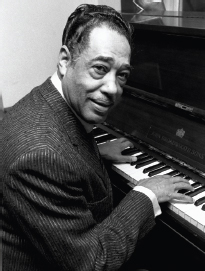Biography: Duke Ellington (1899–1974)

Edward Kennedy Ellington was born in Washington, D.C., son of a butler who occasionally worked at the White House. The young Ellington considered a career as an artist, but he started playing the piano in jazz bands — ragtime was a major influence — and soon organized his own. He learned arranging, too, and became an almost unique phenomenon: a major bandleader who was also its composer and its arranger.
He was called “Duke” because of a certain aristocratic bearing — and he was fastidious about his music, too. Ellington held fast to his own high standards of innovation and stylishness. And although his band never “went commercial,” it did as well as any black band could in the 1930s and 1940s. “Duke Ellington and His Famous Orchestra” were renowned as the backup to sumptuous revues put on at the Cotton Club, an upscale Harlem nightspot that catered to white audiences. Their recordings from around 1930 to 1940 constitute Ellington’s major legacy.
After World War II, Ellington went his own imperturbable way, keeping his big band at a time when such organizations were regarded as jazz dinosaurs. He had experimented with long, symphonic-
Ellington was finally recognized for what he was, just about America’s most eminent composer, and he received the Presidential Medal of Freedom and other tributes. His last creative phase found him writing lengthy religious pieces, called Sacred Concerts, for the Ellington band with a Swedish soprano, Alice Babs, who was not really a jazz singer at all.
Ellington’s Sacred Concerts would have been impossible without Babs — but the same is true of his earlier, better-
Chief Works: Very many songs — one estimate is two thousand — and jazz arrangements ◼ Large-
Encore: Listen to “Mood Indigo,” “Caravan,” “Take the ‘A’ Train,” “Ko-